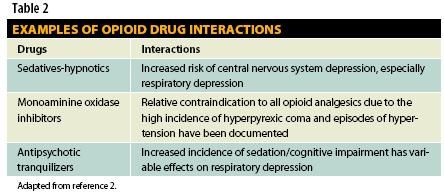Publication
Article
Pharmacy Times
An Overview of Opioids
Author(s):
As the health care community renews its focus on safe opioids prescribing practices, pharmacists have a pivotal role to play in managing this critical therapy for chronic pain.
As a health care community renews its focus on safe opioids prescribing practices, pharmacists have a pivotal role to play in managing this critical therapy for chronic pain.
Opioid analgesic agents have been used for centuries for their analgesic effects and are considered to be the most commonly used pharmacologic agents for the management and treatment of moderate to severe pain. Although these agents are considered safe when used properly and under physician supervision, it is important to understand the risks and benefits associated with prescribing the agents in this pharmacologic class.
Opioids include full agonists, partial agonists, and antagonists. Opioid analgesics exert their pharmacologic effects by binding to specific receptors both within and outside the central nervous system.1 These receptors include mu, delta, and kappa opioid receptors (Table 12,3 ). The effect on mu receptors is considered the most important, with its activation directly linked to both analgesic and euphoric effects.2,4,5 These receptors occur throughout the central nervous system, but particularly in areas and tracts associated with pain perception. Receptors are also located in some sensory nerves, on mast cells, and in some cells of the gastrointestinal (GI) tract.2,5
Opioids can be categorized as endogenous (endorphins, enkephalins, dynorphins), opium alkaloids (morphine, codeine), semisynthetic (oxycodone), or synthetic (methadone, fentanyl). The classes of opioids are phenanthrenes, phenylheptylamines, and phenylpiperidines.2,5
Pharmacokinetics and Routes of Administration
Most opioid analgesics are well absorbed when administered via subcutaneous, intramuscular, and oral routes; however, due to first pass effect, oral doses of opioids may need to be much higher when compared with parenteral doses to achieve the same therapeutic effect.2 Opioids are converted in large part to polar metabolites, which are mostly glucoronides, and are then readily excreted by the kidneys.2 Alternative routes of administration may include patient controlled analgesia, nasal insufflation, oral mucosa via lozenges, and transdermal routes. Transdermal routes provide stable drug plasma levels and are thought to provide better pain control.2 Fetanyl is considered the most successful opioid for transdermal administration and is indicated for use in the management of constant pain often associated with malignancies.2,6 Rectal suppositories of morphine and hydromorphone are sometimes used when oral and parenteral routes are not a feasible route of administration.2
Clinical Uses of Opioids
Analgesia
Opioid analgesics appear to be most effective in treating or managing severe constant pain and are often used in the management of pain in cancer patients or in those with pain associated with other terminal illnesses.2,7 The pain associated with cancer and other terminal illnesses should be treated aggressively to achieve adequate pain relief and often requires a multidisciplinary approach with individualized dosing.2 Often continuous use of potent opioid analgesics may cause concerns about dependence and tolerance.2,7 Opioid analgesics are also often used during obstetric labor; however, because opioids cross the placental barrier and reach the fetus, care and caution must be implemented to minimize the incidence of neonatal depression.2,6 In addition, opioid analgesics are often employed for the acute, severe pain associated with renal and binary colic and often require the use of a strong opioid agonist.2,6
Acute Pulmonary Edema
The use of intravenous morphine provides relief of dyspnea from pulmonary edema associated with left ventricular failure.2,6 Proposed mechanisms of action include reduced awareness of shortness of breath, decreased anxiety levels in patients, and reduced cardiac preload and afterload.2,6
Diarrhea
Opioids from the phenylpiperidine subclass of opioids, which consists of synhthetic opiates, are often used to control diarrhea due to their selective GI effects.2,6 Examples of these agents include diphenoxylate and loperamide.2,6
Cough
Cough suppression can be achieved at doses lower than required for analgesia; however, the use of opioid analgesics for cough suppression has decreased due to the formulation of newer agents, which are nonanalgesic and nonaddictive synthetic agents.2,6 The opioid derivatives most commonly used as antitussives include dextromethophan and codeine.2,6
Anesthesia
Opioids are frequently used as premedicant drugs before anesthesia and surgery because of their sedative, anxiolytic, and analgesic properties.2,6 In addition, these agents are used intraoperatively both as adjunctive therapy and in high doses as a major component of the anesthetic protocol.2,6 Opioids are often used as regional analgesics and administered into the epidural or subarachnoid spaces of the spinal cord. 2 Opioids are also commonly utilized during cardiac and other types of highrisk surgery to minimize cardiovascular depression.2,6
Adverse Effects
Adverse effects associated with opioids include constipation, nausea, vomiting, urinary retention, sedation, impaired cognition, behavioral restlessness, pruritus, miosis, respiratory depression, and postural hypotension.2,7-9 The most common of these adverse effects include constipation, sedation, nausea, vomiting, and pruritus.7 Constipation is considered the most common adverse effect associated with chronic opioid use, because opioids have various GI effects such as decrease in motility, secretions, and blood flow.7-9 Examples of nonpharmacologic measures for managing constipation include increasing fluid and dietary fiber intake, increasing physical activity, and establishing a toileting routine.8 These measures should be implemented to minimize the risk of constipation.8 Monotherapy with stool softeners is often considered ineffective and use of a scheduled stimulant laxative often is required.8 Nausea has been reported to occur in approximately 25% of patients treated with opioids.8 Sedation and decreased cognition are examples of central nervous system adverse effects associated with opioid use. The various strategies often employed to decrease or prevent the adverse effects associated with the use of opioids include dose reduction, symptomatic management, opioid rotation, and changing the route of administration.8,9

When opioids are prescribed, tolerance, potential for dependence, potential for toxicity and its proper treatment, and possible contraindications should always be considered.2 According to the National Institutes of Health’s National Institute on Drug Abuse, opioids, when taken as directed and under physician supervision, can be utilized to manage pain effectively.10 Results from various studies have demonstrated that when properly managed, short-term medical use of opioid analgesic agents can be safe and rarely results in dependence.10
Results from a recent study published in the April 6, 2011, issue of the Journal of the American Medical Association showed that the rate of prescription opioid—related overdose death increased substantially in the United States over the past decade.11 The study stated that these patterns of opioid prescribing may be related to risk of overdose mortality and concluded that among patients receiving opioid prescriptions for pain, higher opioid doses were associated with increased risk of opioid overdose death.11
Pharmacists are instrumental in evaluating the appropriateness of opioid use and monitoring for signs of potential toxicity, dependence, or abuse. Pharmacists should screen for potential drug—drug interactions and contraindications when opioids are prescribed and ensure that patients are counseled on the proper use of these agents as well as the potential adverse effects and signs of toxicity. Examples of opioid drug interactions can be found in Table 2. PT
Table. Opioid Classification
Classification
Examples
Strong Agonists
Phenanthrenes
· Morphine
· Hydromorphone
· Oxymorphone
Phenylheptylamines
· Methadone
Phenylpiperidines
· Fentanyl
· Meperidine
Mild to Moderate Agonists
Phenanthrenes
· Codeine
· Oxycodone
· Hydrocodone
Phenylheptylamines
· Propoxyphene
Phenylpiperidines
· Diphenoxylate
· Loperamide
Opioids with Mixed Receptor Actions
Phenanthrenes
· Nalbuphine
· Buprenophrine
Morphinans
· Butorphanol
Benzomorphans
· Pentazocine
Ms. Terrie is a clinical pharmacy writer based in Haymarket, Virginia.
References
1. Bope E et al. Opioids. In: Conn’s Current Therapy 2011. Elsevier Saunders. MD Consult Web site. www.mdconsult.com/books/page.do?eid=4-u1.0-B978-1-4377-0986-5..00011-9—sc9000&isbn=978-1-4377-0986-5&uniqId=252012899-2. Accessed May 20, 2011.
2. Zhou, Y. Principles of pain management. In: Bradley WG, Daroff RB, Fenichel G, Jankovic J. Neurology in Clinical Practice. 5th ed. MD Consult Web site. www.mdconsult.com/books/page.do?sid=1163819743&eid=4-u1.0-B978-0-7506-7525-3..50058-3&isbn=978-0-7506-7525-3&uniqId=252012899-2. Published 2008. Accessed May 22, 2011.
3. Opioids. Merck Manual for Healthcare Professionals Online Edition. Merck Manual Web site. www.merckmanuals.com/professional/sec15/ch198/ch198f.html.
4. Schumacher M et al. Opioid analgesics and antagonists. In: Katzung Basic and Clinical Pharmacology. 11th ed. New York, NY: McGraw Hill; 2009:531-550.
5. Miner J et al. Pain management. In:Marx: Rosen’s Emergency Medicine. 7th ed. Philadelphia, PA: Mosby; 2010. MD Consult Web site. www.mdconsult.com/books/page.do?eid=4-u1.0-B978-0-323-05472-0..00186-9—s0015&isbn=978-0-323-05472-0&uniqId=251707144-27#4-u1.0-B978-0-323-05472-0..00186-9--t0015.
6. Dews TE, Mekhail N. Safe use of opioids in chronic noncancer pain. Cleve Clin J Med.2004;71(11):897-904.
7. Clinical use: opioid analgesics in pain management. Pharmacology 2000 Web site. www.pharmacology2000.com/Central/Opioid/opioid6.htm#Analgesia.
8. Swegle JM, Logemann C. Management of common opioid-induced adverse effects. Am Fam Physician. 2006;74(8):1347-1354.
9. Canty, Sl. Constipation as a side effect of opioids. Oncol Nurs Forum. 1994;21(4):739-745.
10. Bohnert A et al. Association between opioid prescribing patterns and opioid overdose-related deaths. JAMA. 2011;305(13):1315-1321.







